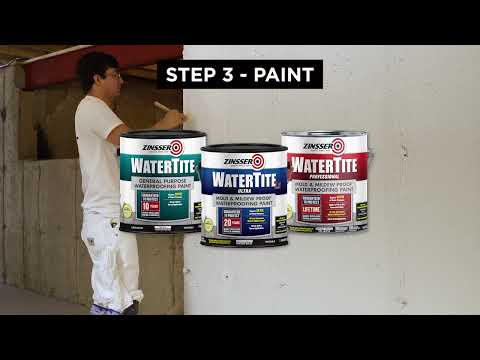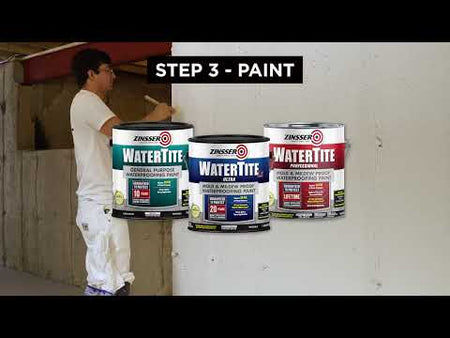COVERAGE
75 sq.ft./gal. (7.4m2/l) (first coat)
100 sq.ft./gal. (9.8m2/l) (second coat)
Coverage may change depending on porosity and application method.
SURFACE PREPARATION
Surfaces must be clean, dry, sound and free of dirt,
greases, soap, and other contaminants. New masonry
must cure for at least 30 days before applying
WaterTite Mold & Mildew-Proof Waterproofing Paint.
Salting or efflorescence (a white powdery deposit oft
en found on walls) must be removed with WaterTite®
Etch and Cleaner or a similar product. Follow manufacturer’s
directions and safety precautions. Rinse the surface thoroughly
with fresh water. Remove all existing mold and mildew. Use a
solution of 1 cup household bleach per gallon of water or
use a mildew cleaner or Jomax®Mold & Mildew Stain Remover. For
commercial buildings, follow appropriate guidelines for mold removal.
If there is a concern about mold and mildew
behind walls, underneath flooring, in ventilation systems or
other unseen areas, contact a professional who
specializes in mold and mildew remediation). Remove
mold and mildew on exterior surfaces with Jomax® House
Cleaner and Mildew Killer.
Previously Painted Surfaces-It can be used over
previously painted, non-glossy surfaces; however its
waterproofing ability is then dependent upon the integrity
of the previous coating. For best results, remove as much
of the old coating as possible by manually scraping the
surface, followed by thorough wire rushing. A belt sander
with a 50 grit sanding belt is also effective. Exterior
surfaces should be power washed or abrasive blasted to
remove all loose and scaling paint and cement.
WARNING!
If you scrape, sand or remove old paint, you
may release lead dust. LEAD IS TOXIC. EXPOSURE TO
LEAD DUST CAN CAUSE SERIOUS ILLNESS, SUCH AS
BRAIN DAMAGE, ESPECIALLY IN CHILDREN.
PREGNANT WOMEN SHOULD ALSO AVOID
EXPOSURE. Wear a NIOSH-Approved respirator to
control lead exposure. Clean up carefully with a HEPA
vacuum and a wet mop. Before you start, find out how to
protect yourself and your family by contacting the National
Lead Information Hotline at 1-800-424-LEAD or log on to
www.epa.gov/lead.
Patching Water Leaks and Cracks-All holes and cracks,
especially active water leaks, must be patched with
WaterTite Polyurethane Sealant or a similar product.
Follow manufacturer’s directions for dry time, etc.
MIXING
Mix thoroughly to ensure any settled pigment is re-dispersed.
DO NOT THIN.
APPLICATION
Use in a well ventilated area. Extinguish all pilot lights and
other sources of flames or ignition. Remove electrical
equipment from the area.
Stir or mix thoroughly before and during application. DO
NOT THIN. Apply only when air, material, and surface
temperatures are between 50-90ºF (10-32ºC) and the
relative humidity is or less than 85%. Liberally apply the
first coat using a thick polyester bristle brush, or by rolling
a small section (3x3 foot) and then using a brush to work
the coating into the pores of the masonry. Apply as much
paint as necessary to produce a continuous, pinhole free
film. Use a 1” nap roller cover for unpainted, porous
surfaces or a ¾” nap roller cover for smooth or previously
painted surfaces. The second coat can be brushed or
rolled.
Color/Tinting - WaterTite Mold & Mildew-Proof
Waterproofing Paint tints easily to beige, blue, and gray
(see back of container label). It can also be tinted to other
off-white and pastel tones. Maximum amount of tint should
not exceed 1.5 ounces (30 ml) per gallon. Mix on a
mechanical shaker for 7-9 minutes or use a drill motor.
Multiple containers of tinted paint should be boxed
(intermixed) to ensure color uniformity.
DRY TIME
Dries to the touch in 1 hour. Allow the first coat to dry a
minimum of 4 hours before applying the second coat. After
the second coat has dried, inspect the surface for
pinholes. Reapply additional paint to those areas as
necessary. After reaching its full cure in 7-14 days (slightly
longer if tinted) WaterTite will stop up to 34 psi of water
pressure. Do not apply if heavy rain is expected with 24
hours.
CLEAN-UP
Wipe up fresh spills and drips with a rag and paint thinner.
To minimize solvent odors, use odorless mineral spirits
and clean application tools outside of the work area.































